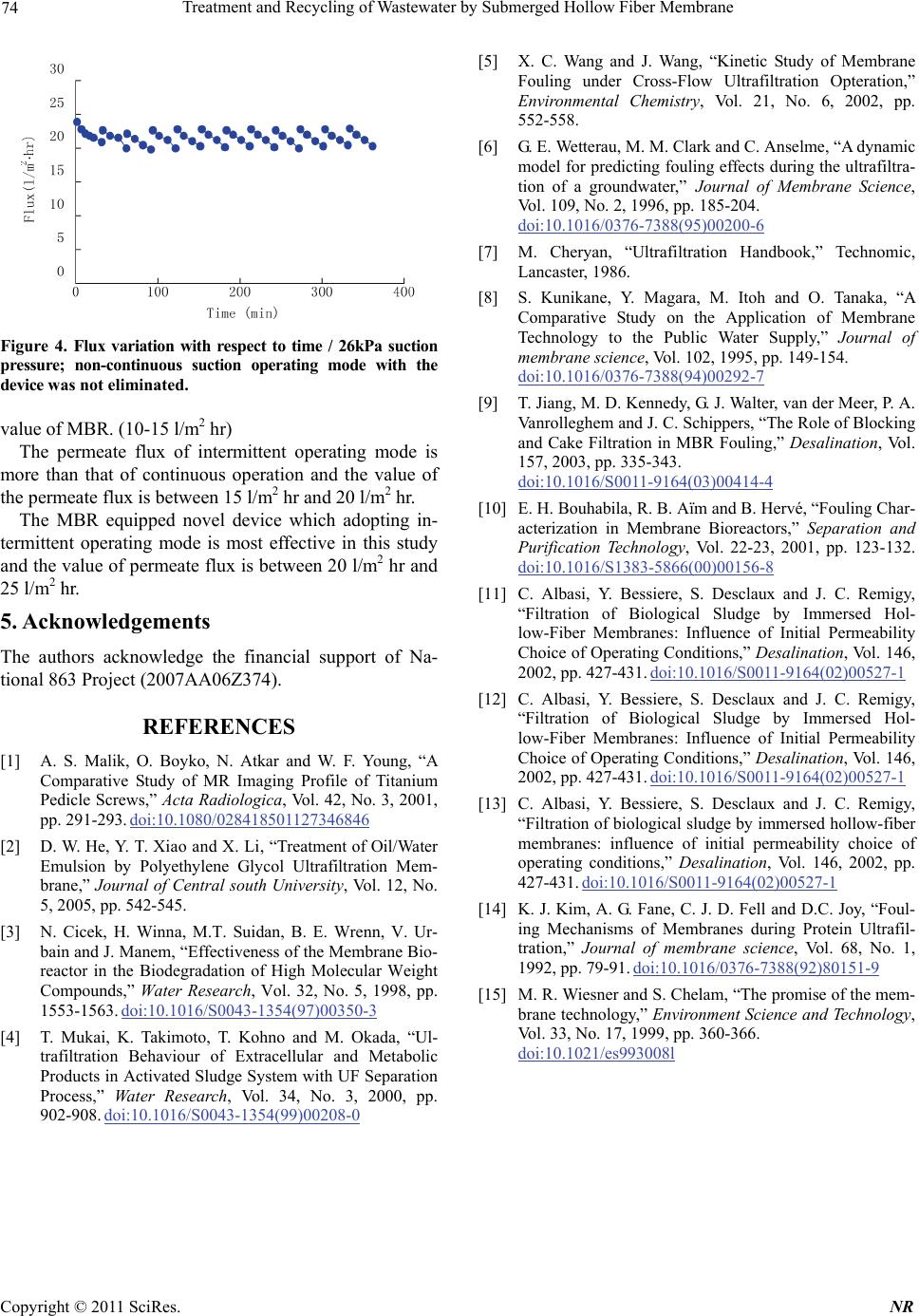
Treatment and Recycling of Wastewater by Submerged Hollow Fiber Membrane
Copyright © 2011 SciRes. NR
74
[5] X. C. Wang and J. Wang, “Kinetic Study of Membrane
Fouling under Cross-Flow Ultrafiltration Opteration,”
Environmental Chemistry, Vol. 21, No. 6, 2002, pp.
552-558.
[6] G. E. Wetterau, M. M. Clark and C. Anselme, “A dynamic
model for predicting fouling effects during the ultrafiltra-
tion of a groundwater,” Journal of Membrane Science,
Vol. 109, No. 2, 1996, pp. 185-204.
doi:10.1016/0376-7388(95)00200-6
[7] M. Cheryan, “Ultrafiltration Handbook,” Technomic,
Lancaster, 1986.
[8] S. Kunikane, Y. Magara, M. Itoh and O. Tanaka, “A
Comparative Study on the Application of Membrane
Technology to the Public Water Supply,” Journal of
membrane science, Vol. 102, 1995, pp. 149-154.
doi:10.1016/0376-7388(94)00292-7
Figure 4. Flux variation with respect to time / 26kPa suction
pressure; non-continuous suction operating mode with the
device was not eliminated.
[9] T. Jiang, M. D. Kennedy, G. J. Walter, van der Meer, P. A.
Vanrolleghem and J. C. Schippers, “The Role of Blocking
and Cake Filtration in MBR Fouling,” Desalination, Vol.
157, 2003, pp. 335-343.
doi:10.1016/S0011-9164(03)00414-4
value of MBR. (10-15 l/m2 hr)
The permeate flux of intermittent operating mode is
more than that of continuous operation and the value of
the permeate flux is between 15 l/m2 hr and 20 l/m2 hr. [10] E. H. Bouhabila, R. B. Aïm and B. Hervé, “Fouling Char-
acterization in Membrane Bioreactors,” Separation and
Purification Technology, Vol. 22-23, 2001, pp. 123-132.
doi:10.1016/S1383-5866(00)00156-8
The MBR equipped novel device which adopting in-
termittent operating mode is most effective in this study
and the value of permeate flux is between 20 l/m2 hr and
25 l/m2 hr. [11] C. Albasi, Y. Bessiere, S. Desclaux and J. C. Remigy,
“Filtration of Biological Sludge by Immersed Hol-
low-Fiber Membranes: Influence of Initial Permeability
Choice of Operating Conditions,” Desalination, Vol. 146,
2002, pp. 427-431. doi:10.1016/S0011-9164(02)00527-1
5. Acknowledgements
The authors acknowledge the financial support of Na-
tional 863 Project (2007AA06Z374).
[12] C. Albasi, Y. Bessiere, S. Desclaux and J. C. Remigy,
“Filtration of Biological Sludge by Immersed Hol-
low-Fiber Membranes: Influence of Initial Permeability
Choice of Operating Conditions,” Desalination, Vol. 146,
2002, pp. 427-431. doi:10.1016/S0011-9164(02)00527-1
REFERENCES
[1] A. S. Malik, O. Boyko, N. Atkar and W. F. Young, “A
Comparative Study of MR Imaging Profile of Titanium
Pedicle Screws,” Acta Radiologica, Vol. 42, No. 3, 2001,
pp. 291-293. doi:10.1080/028418501127346846
[13] C. Albasi, Y. Bessiere, S. Desclaux and J. C. Remigy,
“Filtration of biological sludge by immersed hollow-fiber
membranes: influence of initial permeability choice of
operating conditions,” Desalination, Vol. 146, 2002, pp.
427-431. doi:10.1016/S0011-9164(02)00527-1
[2] D. W. He, Y. T. Xiao and X. Li, “Treatment of Oil/Water
Emulsion by Polyethylene Glycol Ultrafiltration Mem-
brane,” Journal of Central south University, Vol. 12, No.
5, 2005, pp. 542-545. [14] K. J. Kim, A. G. Fane, C. J. D. Fell and D.C. Joy, “Foul-
ing Mechanisms of Membranes during Protein Ultrafil-
tration,” Journal of membrane science, Vol. 68, No. 1,
1992, pp. 79-91. doi:10.1016/0376-7388(92)80151-9
[3] N
. Cicek, H. Winna, M.T. Suidan, B. E. Wrenn, V. Ur-
bain and J. Manem, “Effectiveness of the Membrane Bio-
reactor in the Biodegradation of High Molecular Weight
Compounds,” Water Research, Vol. 32, No. 5, 1998, pp.
1553-1563. doi:10.1016/S0043-1354(97)00350-3
[15] M. R. Wiesner and S. Chelam, “The promise of the mem-
brane technology,” Environment Science and Technology,
Vol. 33, No. 17, 1999, pp. 360-366.
doi:10.1021/es993008l
[4] T. Mukai, K. Takimoto, T. Kohno and M. Okada, “Ul-
trafiltration Behaviour of Extracellular and Metabolic
Products in Activated Sludge System with UF Separation
Process,” Water Research, Vol. 34, No. 3, 2000, pp.
902-908. doi:10.1016/S0043-1354(99)00208-0